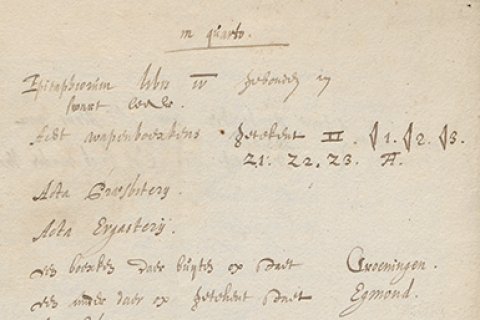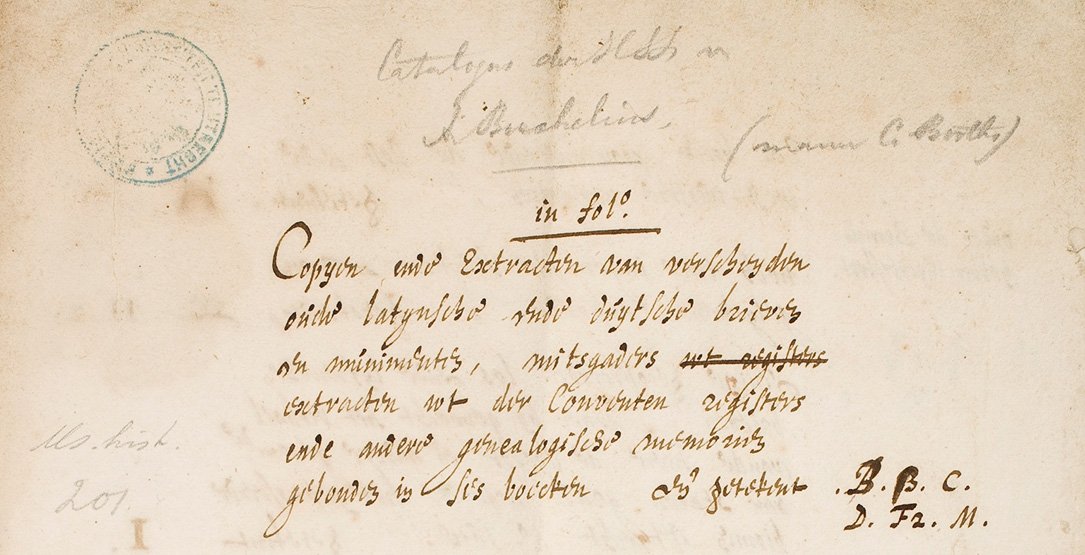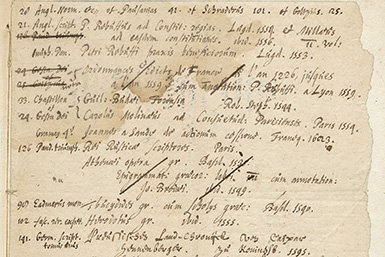'Catalogue of the manuscripts of Aernout van Buchell' by Cornelis Booth

Aernout van Buchell (1565-1641), an amateur historian from Utrecht, produced a considerable number of manuscripts in his lifetime, on a variety of subjects: notes about monuments and genealogy, travel accounts, poems, information on scholars and painters, his ideas about women, remarks about his position in the Dutch East India Company and on the church council, essays about the history of Utrecht, correspondence with friends and family, and many others.
Buchelius’ manuscripts became popular just a short time after his death. Cornelis Booth (1605-1678), the first librarian of the Utrecht university library, wrote one of the documents providing information about the fate of the manuscripts.
The best of families
Sometime between 1641 and 1652, Cornelis Booth recorded the manuscripts by Buchelius which he himself owned and those which he knew could be found elsewhere. In this case, ‘elsewhere’ meant: in the hands of his family members. Three of the people named on his list were members of his family. Firstly, there was Johan van Nellesteyn (1607-1677), who signed the list along with Booth, and is referred to as a neeff ('nephew; cousin'). The second was Adolphus Vorstius, another neeff and finally Cornelis van Wijckersloot, bewindhebber ('commander') of the Dutch East India Company.
Booth’s great interest in Buchelius’ manuscripts had not only to do with his genealogical studies, but also with the fact that he and Buchelius were related. Johan van Nellesteyn was a cousin of both Buchelius and Booth, Vorstius was Buchelius’ first cousin and Booth’s second cousin, and Van Wijckersloot was Booth’s father-in-law and the son of Buchelius’ sister-in-law. All of these families belonged to the Utrecht aristocracy, and were well connected in political and cultural circles, which explains why Buchelius’ manuscripts were owned mostly by Booth and his relatives.

Identification of the manuscripts
Ms. 1831 demonstrates that Buchelius designated his manuscripts certain symbols and numbers, which were adopted by Booth. They are still visible on the spine or the edge of some manuscripts. Some of the manuscripts on the list can easily be identified as existing manuscripts, while identification of others is not possible, or they have probably been lost.
The list’s value can be attributed not only to the overview it provides of Buchelius’ interests and activities, but also the key information it gives about the collection’s history. Buchelius’ genealogical and historical notes, in particular, as well as his collection in general had a profound impact on Booth and many others. The list will have to be examined more closely in order to trace the provenance of Buchelius’ manuscripts in more detail.

Booth’s notes in his role as librarian
The list includes Booth’s notes on the collection held in the Utrecht city library, probably compiled between 1670 and 1678, when Booth published the first part of the city library catalogue and was working on the second part, eventually published in 1678. It offers a glimpse of a librarian’s daily work. Booth appears to have been searching for books that had seemingly disappeared from his collection.

